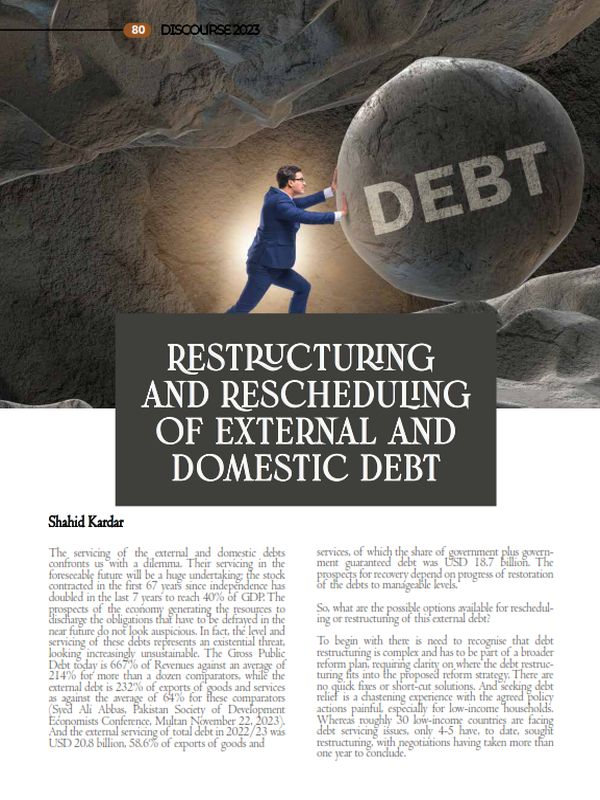Restructuring and Rescheduling of External and Domestic Debt
The servicing of the external and domestic debts confronts us with a dilemma. Their servicing in the foreseeable future will be a huge undertaking; the stock contracted in the first 67 years since independence has doubled in the last 7 years to reach 40% of GDP. The prospects of the economy generating the resources to discharge the obligations that have to be defrayed in the near future do not look auspicious. In fact, the level and servicing of these debts represents an existential threat, looking increasingly unsustainable. The Gross Public Debt today is 667% of Revenues against an average of 214% for more than a dozen comparators, while the external debt is 232% of exports of goods and services as against the average of 64% for these comparators (Syed Ali Abbas, Pakistan Society of Development Economists Conference, Multan November 22, 2023). And the external servicing of total debt in 2022/23 was USD 20.8 billion, 58.6% of exports of goods and services, of which the share of government plus government guaranteed debt was USD 18.7 billion. The prospects for recovery depend on progress of restoration of the debts to manageable levels.
So, what are the possible options available for rescheduling or restructuring of this external debt?
To begin with there is need to recognise that debt restructuring is complex and has to be part of a broader reform plan, requiring clarity on where the debt restructuring fits into the proposed reform strategy. There are no quick fixes or short-cut solutions. And seeking debt relief is a chastening experience with the agreed policy actions painful, especially for low-income households. Whereas roughly 30 low-income countries are facing debt servicing issues, only 4-5 have, to date, sought restructuring, with negotiations having taken more than one year to conclude.
Much of our debt (44%-50%) is owed to multilaterals (IMF, World Bank, ADB). A significant proportion of this debt is at highly concessional rates, which makes these institutions preferred creditors, whose lending cannot be restructured or rescheduled under the present scheme of things.
In the case of bilaterals, the stock of debt of the Paris Club members (OECD plus Japan) that was eligible for rescheduling in 2001/02 is repayable in the latter half of the twenty thirties (2030s). This leaves us with the Chinese, Saudis and UAE (who are not a members of the Paris Club) and commercial debts (20% of total debt) to deal with. So far, the Chinese have only been rolling over repayments as and when they become due. Another complication is how to categorise a Chinese lending institution – bilateral or commercial.
As for the commercial debt, it will require the umbrella of the G7 to get negotiations underway – easier said than done. They charge risk premium interest rates but still insist on being paid in full and are legally covered by NY laws. There is also the complication of the seniority principle likely to be invoked in the case of Foreign Currency Swaps and Saudi and UAE Deposits with the SBP.
And the Sri Lankan and other countries’ experiences suggest that there will need to be transparency and parity in debt restructuring treatment of major creditors, consistent with IMF’s debt sustainability analysis (i.e. the country has to be in a Fund program).
However, even to be able to seek some write down of the external debt or its rescheduling/reprofiling will, to enable the building of a case with the creditors, require a) us to present our plan of the reforms (somewhat along the lines detailed in this paper) that we will undertake to demonstrate to the lenders our commitment to prevent the return of the conditions requiring debt relief; and b) similar adjustments that will have to be made in domestic debt.
And the case of domestic debt is equally stark. The servicing of the interest on this debt (which consumes 90% of the annual budgetary allocations for interest payments) requires mobilisation of a primary surplus of more than 7% of GDP! The reduction (or liquidation) of this debt will require a gradual approach, involving a combination of negative real interest rates, a moratorium on or suspension of interest payments for say two years, some extension of the maturity periods and even some write-down of its face value. The fourth/fifth option, although not the ideal way forward, could be a higher tax rate on bank incomes.
The author is a former Governor of the State Bank of Pakistan and former Minister for Finance and Planning in the Government of Punjab.





